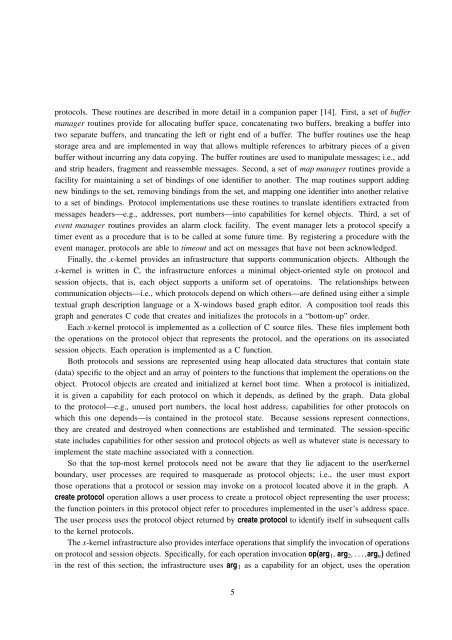The x-Kernel: An architecture for implementing network protocols - IDA
The x-Kernel: An architecture for implementing network protocols - IDA
The x-Kernel: An architecture for implementing network protocols - IDA
Create successful ePaper yourself
Turn your PDF publications into a flip-book with our unique Google optimized e-Paper software.
<strong>protocols</strong>. <strong>The</strong>se routines are described in more detail in a companion paper [14]. First, a set of buffer<br />
manager routines provide <strong>for</strong> allocating buffer space, concatenating two buffers, breaking a buffer into<br />
two separate buffers, and truncating the left or right end of a buffer. <strong>The</strong> buffer routines use the heap<br />
storage area and are implemented in way that allows multiple references to arbitrary pieces of a given<br />
buffer without incurring any data copying. <strong>The</strong> buffer routines are used to manipulate messages; i.e., add<br />
and strip headers, fragment and reassemble messages. Second, a set of map manager routines provide a<br />
facility <strong>for</strong> maintaining a set of bindings of one identifier to another. <strong>The</strong> map routines support adding<br />
new bindings to the set, removing bindings from the set, and mapping one identifier into another relative<br />
to a set of bindings. Protocol implementations use these routines to translate identifiers extracted from<br />
messages headers—e.g., addresses, port numbers—into capabilities <strong>for</strong> kernel objects. Third, a set of<br />
event manager routines provides an alarm clock facility. <strong>The</strong> event manager lets a protocol specify a<br />
timer event as a procedure that is to be called at some future time. By registering a procedure with the<br />
event manager, <strong>protocols</strong> are able to timeout and act on messages that have not been acknowledged.<br />
Finally, the x-kernel provides an infrastructure that supports communication objects. Although the<br />
x-kernel is written in C, the infrastructure en<strong>for</strong>ces a minimal object-oriented style on protocol and<br />
session objects, that is, each object supports a uni<strong>for</strong>m set of operatoins. <strong>The</strong> relationships between<br />
communication objects—i.e., which <strong>protocols</strong> depend on which others—are defined using either a simple<br />
textual graph description language or a X-windows based graph editor. A composition tool reads this<br />
graph and generates C code that creates and initializes the <strong>protocols</strong> in a “bottom-up” order.<br />
Each x-kernel protocol is implemented as a collection of C source files. <strong>The</strong>se files implement both<br />
the operations on the protocol object that represents the protocol, and the operations on its associated<br />
session objects. Each operation is implemented as a C function.<br />
Both <strong>protocols</strong> and sessions are represented using heap allocated data structures that contain state<br />
(data) specific to the object and an array of pointers to the functions that implement the operations on the<br />
object. Protocol objects are created and initialized at kernel boot time. When a protocol is initialized,<br />
it is given a capability <strong>for</strong> each protocol on which it depends, as defined by the graph. Data global<br />
to the protocol—e.g., unused port numbers, the local host address, capabilities <strong>for</strong> other <strong>protocols</strong> on<br />
which this one depends—is contained in the protocol state. Because sessions represent connections,<br />
they are created and destroyed when connections are established and terminated. <strong>The</strong> session-specific<br />
state includes capabilities <strong>for</strong> other session and protocol objects as well as whatever state is necessary to<br />
implement the state machine associated with a connection.<br />
So that the top-most kernel <strong>protocols</strong> need not be aware that they lie adjacent to the user/kernel<br />
boundary, user processes are required to masquerade as protocol objects; i.e., the user must export<br />
those operations that a protocol or session may invoke on a protocol located above it in the graph. A<br />
create protocol operation allows a user process to create a protocol object representing the user process;<br />
the function pointers in this protocol object refer to procedures implemented in the user’s address space.<br />
<strong>The</strong> user process uses the protocol object returned by create protocol to identify itself in subsequent calls<br />
to the kernel <strong>protocols</strong>.<br />
<strong>The</strong> x-kernel infrastructure also provides interface operations that simplify the invocation of operations<br />
on protocol and session objects. Specifically, <strong>for</strong> each operation invocation op(arg 1 , arg 2 ,...,arg n ) defined<br />
in the rest of this section, the infrastructure uses arg 1 as a capability <strong>for</strong> an object, uses the operation<br />
5

















